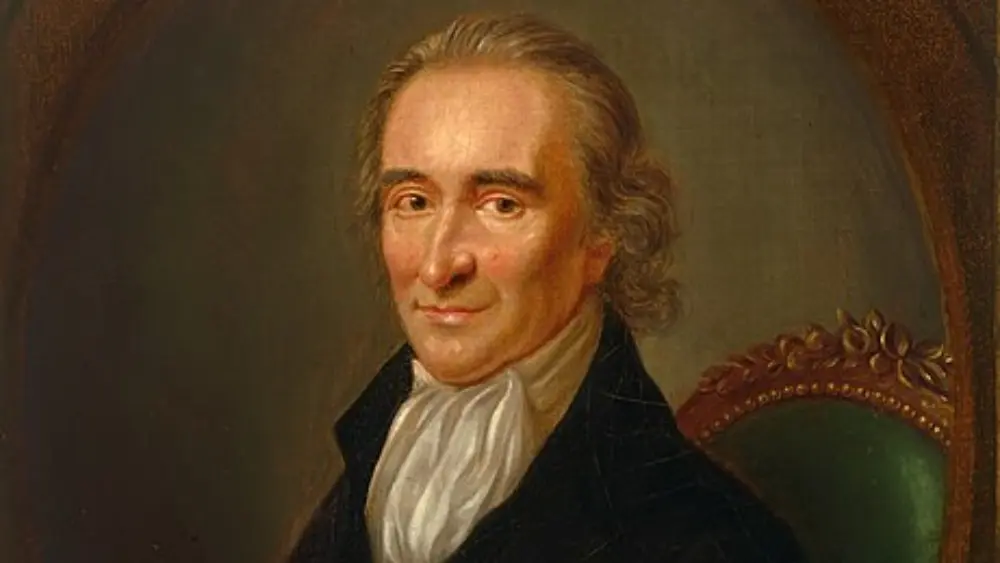Thomas Paine, born on January 29, 1737, in the modest town of Thetford, England, remains a pivotal figure in the history of both the American and French Revolutions. While widely recognized for revolutionary writings such as Common Sense and The American Crisis, one of his most daring and intellectually provocative works emerged later in his life—The Age of Reason. Published in two parts in 1794 and 1795, this philosophical treatise was a bold critique of organized religion and a call to embrace rational inquiry over inherited faith. Though highly controversial, the book stands as a cornerstone of Enlightenment thought, embodying Paine’s unwavering dedication to truth and individual liberty.
Early Life and Arrival in America
Paine’s early life was shaped by hardship and limited access to education. His father, a Quaker corset maker, and his mother, an Anglican, raised him with modest means. He received only a basic education and began working at a young age. Yet Paine’s intellect burned brightly from the outset, and he developed a voracious appetite for learning through self-education. As a young man, he worked a variety of jobs—including excise officer, teacher, and shopkeeper—experiences that exposed him to the rigid social hierarchies and economic injustices of 18th-century England.
In 1774, facing personal and financial setbacks, Paine immigrated to the American colonies with a recommendation letter from none other than Benjamin Franklin. He arrived in Philadelphia, a city pulsing with revolutionary energy. Within two years, he would pen one of the most influential political pamphlets in American history.
A Revolutionary Voice: Common Sense and The American Crisis
In 1776, Paine published Common Sense, a passionate argument for American independence that became an immediate sensation. Writing in plain language accessible to ordinary people, he dismantled the legitimacy of the British monarchy and advocated for a democratic republic. The pamphlet sold over 100,000 copies in its first few months—an astonishing figure for the time—and played a major role in galvanizing public support for independence.
During the Revolutionary War, as morale declined among soldiers and civilians alike, Paine wrote The American Crisis, a series of essays that inspired perseverance in the face of adversity. Its famous opening line, “These are the times that try men’s souls,” became a rallying cry for the struggling Continental Army. George Washington ordered it read aloud to troops before a surprise attack on Trenton, a moment that helped turn the tide of the war.
Through these works, Paine became known not just as a writer but as a revolutionary force whose words could rouse nations. His influence in shaping democratic ideals was profound, but he was far from finished.
Turning Toward Faith and Reason: The Age of Reason, Part I
Following the American Revolution, Paine traveled to France and was swept up in the revolutionary fervor sweeping that nation. He was elected to the French National Convention and initially supported the French Revolution’s ideals. However, Paine’s opposition to the execution of King Louis XVI put him at odds with the radical Jacobins. He was arrested in 1793 during the Reign of Terror and imprisoned for nearly a year.
It was during this confinement that Paine began writing The Age of Reason: Being an Investigation of True and Fabulous Theology. The first part, published in 1794, outlined his deist beliefs and launched a sweeping critique of institutionalized religion. Paine asserted that while he believed in God, he rejected the divine authority of the Bible and the miracles described within it.
He challenged the legitimacy of religious texts, arguing that men wrote them and filled them with contradictions, inconsistencies, and errors. He claimed that revelation is personal; once someone communicates it secondhand, it loses its authenticity and becomes hearsay. Paine contended that the natural world, observable and consistent, was the true testament to the Creator’s existence.
Unlike many critics of religion, Paine did not write from a place of bitterness but from a sincere belief in the power of reason. He urged readers to apply logic and evidence to all areas of life—including faith.
The Second Strike: The Age of Reason, Part II
In 1795, Paine released the second part of The Age of Reason, deepening his critique. This installment included a more detailed examination of the Bible. This is where Paine analyzed scripture to expose what he saw as historical and ethical flaws. He pointed to inconsistencies between gospel accounts and challenged moral teachings that he viewed as incompatible with reason and justice.
Paine’s tone remained firm but civil. He did not ridicule religious believers but sought to free them from what he believed were manipulative systems that suppress critical thinking. His call for reform went beyond theology—it was a plea for intellectual independence.
He championed a society where conscience guides moral behavior, not fear of divine punishment or adherence to dogma. Paine believed in the power of human reason to shape a just and compassionate society, independent of religious authority.
Imprisonment and the Risk of Ideas
Paine’s time in prison nearly cost him his life. He fell seriously ill, and only through a twist of fate. A chalk mark was mistakenly placed on the inside of his cell door instead of the outside, sparing him from execution. He was released in 1794 following the fall of Robespierre. After his release, he resumed work on The Age of Reason. He continued his efforts to guide revolutionary thought toward humane and rational principles.
His imprisonment underscores the danger he faced for expressing ideas that challenged power structures, both political and religious. At a time when heresy and treason could result in death, Paine’s courage in defending reason remains deeply significant.
A Firestorm of Controversy
Unsurprisingly, The Age of Reason sparked widespread condemnation. Religious leaders denounced Paine as blasphemous and morally depraved. British authorities banned the book and threatened publishers with imprisonment if they printed it. In America, where the public had once celebrated Paine, society turned its back on him. Even some of his former allies distanced themselves, fearing association with his religious views.
Critics falsely labeled him an atheist, ignoring his clear statements about believing in a creator. Their outrage drowned out the nuance of his argument, turning the book into a symbol of radicalism and anti-clericalism.
Enlightenment thinkers, reformers, and proponents of religious freedom embraced The Age of Reason. The book circulated among intellectual circles and became a beacon for those advocating secular governance, education reform, and free expression.

A Legacy of Enlightenment
Though Paine’s final years were fraught with poverty and neglect, his influence extended far beyond his immediate time. The philosophical foundations he helped lay contributed to enduring values enshrined in liberal democracies: freedom of speech, freedom of religion, and the separation of church and state.
The U.S. Constitution, particularly the First Amendment, protects religious liberty and prevents any single doctrine from controlling law and policy—reflecting the kind of society Paine envisioned. His writings helped move Western civilization closer to this vision.
Moreover, Paine’s critiques encouraged people to think critically about inherited beliefs. He showed that reason and spirituality need not be enemies. And that questioning dogma was not a threat to morality but a path to intellectual growth.
Final Years and Re-Emerging Respect
When Paine returned to America in 1802, his reception was cold. His earlier contributions had been largely overshadowed by the backlash to The Age of Reason. Barred from voting, struggling financially, and suffering from ill health, he lived out his remaining years in obscurity. He died on June 8, 1809, in New York, with only a handful of people attending his funeral.
For decades, his reputation languished. But as the 19th and 20th centuries progressed, scholars and activists began to re-evaluate his work. Figures in social justice movements, secular organizations, and free speech advocacy found inspiration in Paine’s writings. His commitment to justice, truth, and the rights of the individual began to receive renewed appreciation.
Today, people recognize Thomas Paine not only as a founding figure of American independence but also as a global icon of Enlightenment values. Institutions, authors, and educators now honor his role in shaping modern political and philosophical thought.
Conclusion: Reason as a Revolutionary Tool
Thomas Paine’s The Age of Reason was not simply a book about theology—it was a manifesto for intellectual liberation. At a time when challenging religious orthodoxy was dangerous, Paine confronted centuries of tradition. He called on humanity to rise above fear and embrace inquiry. He pursued truth fearlessly, even when faced with condemnation and exile. His example stands as a timeless testament to moral and philosophical courage.
In a world still grappling with the balance between faith and reason, Paine’s work remains relevant. It reminds us that difficult questions often spark progress, and we must protect the freedom to ask them at all costs.
Whether through revolutions fought with pamphlets or with principles, Thomas Paine’s life stands as a testament to the enduring power of ideas—and the unshakable belief that reason, when wielded with honesty and purpose, can change the course of history.








